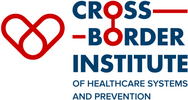
CHARE-GD II Subproject 1: Establishing a Health and Contextual Data Inventory to Facilitate Interdisciplinary Cross-Border Research
CHARE-GD II Subproject 1: Establishing a Health and Contextual Data Inventory to Facilitate Interdisciplinary Cross-Border Research
PIs: Prof. Dr. Sebastian Schnettler, Dr. Tobias Vogt, Prof. Dr. Viola Angelini
For other languages, see Nederlands and Deutsch.

About the project
Cross-border health research is heavily reliant on comparable data sources to analyse the differences and similarities between both sides of the border. As a result, Subproject 1 of the CHARE-GD II aims to establish a Cross-border Health Data Inventory which will facilitate interdisciplinary cross-border research. This inventory will provide an overview of available health and contextual data sources covering the Ems-Dollard region and their suitability, particularly for comparative research purposes.
Population health differences in cross-border regions within the European Union and Schengen area: a protocol for a scoping review
European integration and the abolition of border controls within the European Union (EU) have improved the living conditions and health of the population over the last thirty years. Among other things, this has led to economic convergence, and increased cultural exchange and cooperation in the healthcare sector. However, despite these positive developments, socio-spatial health inequalities still exist within and between Member States. While the causes of health inequalities at the national and regional levels have been studied in detail, little attention has been paid to cross-border regions. However, such regions offer unique opportunities to analyse the impact of European integration on the health of the population. On the one hand, the inhabitants often share a common historical and cultural background, on the other hand, they are exposed to two different healthcare systems.
Aim of the study
This study aims to analyse how health indicators have changed over time in cross-border areas of the EU using existing research. It also aims to identify the types of data sources used in the respective studies and research gaps in the existing literature.
Method
In this study, we will conduct a comprehensive literature review. We will follow the guidelines of the Joana Briggs Institute. Using these guidelines, we will define the inclusion and exclusion criteria to determine which studies will be included and discussed in our literature search. A comprehensive search strategy is conducted in several literature databases as well as on the websites of international governmental organisations. The results will be collated in a table and accompanied by a narrative summary.
Implications
Understanding the health situation in cross-border regions is essential for promoting economic and social unity within the EU. This study can help to identify knowledge gaps and develop policies to address health inequalities between EU Member States. It contributes to the ongoing discussions on the harmonisation of healthcare in the EU by highlighting the impact of European integration on cross-border regions.
Would you like to know more?
You can find this study here: https://bmjopen.bmj.com/content/bmjopen/13/8/e068571.full.pdf
Stroisch, S., Angelini, V., Schnettler, S., & Vogt, T. (2023). Population health differences in cross-border regions within the European Union and Schengen area: a protocol for a scoping review. BMJ open, 13(8), e068571.
Health Outcomes in EU Cross-Border Regions: A Scoping Review
The Purpose of the Study
In the European Union, efforts to bring countries closer together have focused on improving living conditions and access to healthcare. With fewer border controls and the ability to travel freely, people living in border areas can access more healthcare services. However, these regions are exposed to different healthcare systems, which can lead to varying health outcomes that are important to explore but yet understudied. This review examines available studies investigating trends in health outcomes for people living in cross-border regions of Europe. It aims to synthesise existing information and highlight areas where further research is needed.
The main findings
The review did not identify any comprehensive studies that tracked the health of populations over time. Instead, most research has focused on specific diseases or health issues in certain border regions, particularly around Germany. Most of these studies captured data at a single point in time rather than across multiple years. Five main themes emerged from the research: antibiotic resistance, the impact of COVID-19, other infectious diseases, cancer survival rates, and additional health indicators.
Implications
The findings suggest that much of the research in border areas has centred on the spread of infectious diseases, with less emphasis on how European integration influences long-term health trends for these communities as a whole.
Would you like to know more?
The full article can be accessed here: https://doi.org/10.3389/phrs.2025.1608170
Stroisch, S., Angelini, V., Schnettler, S., & Vogt, T. (2025). Health Outcomes in EU Cross-Border Regions: A Scoping Review. Public Health Reviews, 46, 1608170.
Getting closer to each other? Convergence and divergence patterns of life expectancy in 277 border regions of Western Europe 1995–2019
Purpose of this study
This study analysed life expectancy trends in 277 border regions across 12 Western European countries from 1995, the year the Schengen Agreement was implemented, to 2019. Its goal was to identify patterns of mortality convergence or divergence in these unique areas that are shaped by both national policies and cross-border integration. The analysis assessed improvements by comparing each border region against three different reference groups: adjacent border regions in neighbouring countries, non-border regions within the same country, and the average of all 12 Western European countries combined.
Main findings
The research found that life expectancy increased in all border regions, though the pace of improvement varied considerably. While some areas showed notable progress and convergence, such as the Alpine regions along the Italian and Swiss borders, others have fallen behind. This is particularly evident in the border regions of Western Germany's old industrial areas, which have lagged or diverged from neighbouring regions and the Western European average.A key finding was that health disparities were more pronounced betweenthe border regions of neighbouring countries than within a single country (i.e., between its border and non-border areas), highlighting the persistent influence of national contexts
Implications
The study's findings suggest that despite decades of EU integration efforts, national policies and regional contexts remain dominant factors shaping health outcomes. The persistent disparities indicate that EU cohesion funds, which rely heavily on economic metrics like GDP, have had limited success in harmonising health standards. The authors propose that incorporating health indicators, such as mortality measures, into funding allocation criteria could better target regions facing significant health challenges. Finally, cross-border regions can serve as "experimental laboratories" for policy learning, where underperforming areas can adopt successful strategies from their neighbours.
Would you like to know more?
The full article can be accessed here: https://doi.org/10.1007/s10654-025-01279-w
Stroisch, S., Grigoriev, P., Mühlichen, M., Hrzic, R., & Vogt, T. (2025). Getting closer to each other? Convergence and divergence patterns of life expectancy in 277 border regions of Western Europe 1995–2019. European Journal of Epidemiology.

